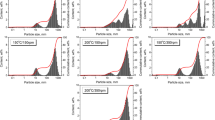Abstract
In this paper, a novel polyurethane grouting foam materials (PGFM) were optimized with the polyether polyol species, molecular weight, functional degree, isocyanate index, chain extender contents, catalyst species and contents into the desired formula. Such optimized formulation design disclosed that the PGFM had the best comprehensive performance when the isocyanate index was of 1.2, polyether molecular weight of 500–800, functional degree of 3–4, and chain extender at 3% and the catalyst dosage C1 0.4% and C2 0.2%. Intensive investigation in the molding density of PGFM influence on mechanical properties, water absorption, frost/acid/alkali resistant, aging performance, environmental properties and safety tested by experiment was found that PGFM had the low water absorption rate, excellent mechanical properties, dimensional stability frost/acid/alkali resistance and safe and environmentally friendly. Lastly, after injecting polymer grouting material into the lift track, the durability and dispersion of PGFM were also tested to confirm its engineering application feasibility for high-speed railway lifting track structure. It revealed that the PGFM evenly distributed under the concrete base plate and the surface of the track subgrade. The grouting filler can not only distribute evenly on the surface of the subgrade, but also enter into the interior of the subgrade along with the graded gravel pores, which further played an important role in strengthening the subgrade.
Access this chapter
Tax calculation will be finalised at checkout
Purchases are for personal use only
Similar content being viewed by others
References
Buzzi O, Fityus S, Sasaki Y, Sloan S (2008) Structure and properties of expanding polyurethane foam in the context of foundation remediation in expansive soil. Mech Mater 40(8):1012–1021
Rindle JA (1970) Reinforcing mechanism in PU foams. J Cell Plast 6(30):280–287
Yang ZG, Zhao B, Qin SL, Hu ZF, ** ZK, Wang JH, Hu ZF (2004) Study on the mechanical properties of hybrid reinforced rigid polyurethane composite foam. J Appl Polym Sci 92(3):1493–1500
Bian XC, Jiang HG, Chen YM (2010) Accumulative deformation in railway track induced by high-speed traffic loading of the trains. Earthq Eng Eng Vibr 9(3):319–326
Bezazi A, Scarpa F (2007) Mechanical behaviour of conventional and negative Poisson’s ratio thermoplastic polyurethane foams under compressive cyclic loading. Int J Fatigue 29(5):922–930
Buzzi O, Fityus S, Sloan S (2010) Use of expanding polyurethane resin to remediate expansive soil foundations. Can Geotech J 47:623–634
Ford CM, Gibson LJ (1998) Uniaxial strength asymmetry in cellular materials: an analytical model. Int J Mech Sci 40(6):521–531
Youssef S, Maire E, Gaertner R (2005) Finite element modelling of the actual structure of cellular materials determined by X-ray tomography. Acta Mater 53:719–730
Shen Y, Golnaraghi F, Plumtree A (2001) Modeling compressive cyclic stress-strain behaviour of structural foam. Int J Fatigue 23:491–497
Mills N, Lyn G (2002) Modeling air flow in impacted polyurethane foam. Cell Polym 21:343–365
Acknowledgements
This work was supported by the research project of China Railway Shanghai Administration Group Co. Ltd. (No. 2017026). The authors also thank Dr. **song Tang for additional financial and technical support.
Author information
Authors and Affiliations
Corresponding author
Editor information
Editors and Affiliations
Rights and permissions
Copyright information
© 2020 Springer Nature Singapore Pte Ltd.
About this paper
Cite this paper
Han, W. et al. (2020). Study on Properties of Polyurethane Grouting Foam Material for High-Speed Railway Track Lifting. In: Tutumluer, E., Chen, X., **ao, Y. (eds) Advances in Environmental Vibration and Transportation Geodynamics. Lecture Notes in Civil Engineering, vol 66. Springer, Singapore. https://doi.org/10.1007/978-981-15-2349-6_33
Download citation
DOI: https://doi.org/10.1007/978-981-15-2349-6_33
Published:
Publisher Name: Springer, Singapore
Print ISBN: 978-981-15-2348-9
Online ISBN: 978-981-15-2349-6
eBook Packages: EngineeringEngineering (R0)




